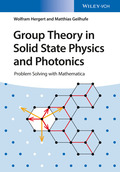Group Theory in Solid State Physics and Photonics
Problem Solving with Mathematica

1. Edition June 2018
377 Pages, Softcover
100 Pictures
Textbook
Short Description
While group theory is well established, this textbook raises two completely new aspects: gaining a better understanding by focusing on problem solving, making extensive use of Mathematica; offering a new tool for photonics by applying the concepts to photonic fibers and crystals.
Buy now
Price: 105,00 €
Price incl. VAT, excl. Shipping
Euro prices for Wiley-VCH and Ernst & Sohn titles are only valid for Germany. In EU countries, local VAT applies. Postage will be charged.
While group theory and its application to solid state physics is well established, this textbook raises two completely new aspects. First, it provides a better understanding by focusing on problem solving and making extensive use of Mathematica tools to visualize the concepts. Second, it offers a new tool for the photonics community by transferring the concepts of group theory and its application to photonic crystals.
Clearly divided into three parts, the first provides the basics of group theory. Even at this stage, the authors go beyond the widely used standard examples to show the broad field of applications. Part II is devoted to applications in condensed matter physics, i.e. the electronic structure of materials. Combining the application of the computer algebra system Mathematica with pen and paper derivations leads to a better and faster understanding. The exhaustive discussion shows that the basics of group theory can also be applied to a totally different field, as seen in Part III. Here, photonic applications are discussed in parallel to the electronic case, with the focus on photonic crystals in two and three dimensions, as well as being partially expanded to other problems in the field of photonics.
The authors have developed Mathematica package GTPack which is available for download from the book's homepage. Analytic considerations, numerical calculations and visualization are carried out using the same software. While the use of the Mathematica tools are demonstrated on elementary examples, they can equally be applied to more complicated tasks resulting from the reader's own research.
2 Introduction
I Basics of group theory
3 Symmetry operations and transformations of fields
4 Basic abstract group theory
5 Discrete symmetry groups for solid state physics and photonics
6 Representation theory
7 Symmetry in k-space
II Applications in electronic structure theory
8 Solution of the Schroedinger equation
9 Generalization to include the spin
10 Electronic energy bands
III Applications in photonics
11 Solution of Maxwell's equations
12 Twodimensional photonic crystals
13 Threedimensional photonic crystals
14 Other Applications
A Mathematica Package Reference
B Connection of the group theory package to MPB and MEEP
R. Matthias Geilhufe is currently a post-doctoral researcher at the Nordic Institute for Theoretical Physics (Nordita) in Stockholm (Sweden). He completed his undergraduate and postgraduate studies at the Martin Luther University Halle-Wittenberg (Germany) with specialization in theoretical and computational physics and did his PhD in connection with the Max Planck Institute of Microstructure Physics in Halle. His main research interests are in condensed matter theory, in particular functional organic materials, Dirac materials, superconductivity, and topological band theory.


